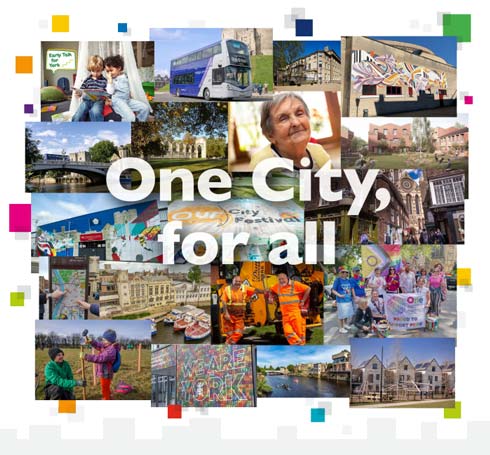Priority f) Sustainability: Cutting carbon, enhancing the environment for our future
Climate change is the greatest threat facing our planet. In York, we are committed to tackling this threat and in 2019, Full Council declared a climate emergency, set an ambition for York to be net zero carbon by 2030 and establishing an independent Climate Commission for the city. Reducing our carbon emissions, adapting to a changing climate and enhancing our environment are crucial for our future generations to enjoy the same quality of life we do today. There are challenges in getting to where we need to be by 2030; but they are achievable, and have the potential to deliver significant economic, social and environmental benefits beyond our climate emergency commitment. Throughout our actions we will ensure the financial burden of climate action is not carried by those who can least afford it.
Key statistics
- Overall carbon emissions: 51.3% down between 2005 and 2020 (mostly due to decarbonisation of the national grid) (data source: DBEIS - UK local authority and regional greenhouse gas emissions national statistics).
- Council emissions: 4% of the city’s total carbon emissions.
- 11% current tree canopy cover in York, 13% target tree canopy cover.
- Air Quality It is not acceptable for York to breach national regulations; 4.4% of all deaths in York are attributable to poor air quality (data source: Page 35 xxxiii of fingertips.phe.org.uk).
- Average concentration of nitrogen dioxide (NO2) was 19% (*1) down between 2018 and 2022.
- 47µg/m3 on Gillygate(*2) / 40µg/m3 health-based standard.
- Average concentration of fine particulate (PM2.5).
- 18%(*3) down between 2018 and 2022.
- Within the government’s annual mean target level of 10µg/m3.
- Above the World Health Organisation’s (WHO) annual mean guideline of 5µg/m3.
(*1) % change in average of annual mean NO2 concentrations monitored at Bootham, Fishergate, Holgate Road, Nunnery Lane, Gillygate, Lawrence Street, Heworth Green and Fulford Road automatic monitoring sites between 2018 and 2022.
(*2) annual mean NO2 concentration monitored at diffusion tube site ‘14’ in 2022.
(*3) % change in average of annual mean PM2.5 concentrations monitored at Bootham, Gillygate and Fishergate automatic monitoring sites between 2018 and 2022.
Modelling done by the Public Health team at Merton Council, a similar sized local authority to York, has shown the health co-benefits of their sustainability aspirations – measured by an increase in active travel, healthier and more sustainable diets, housing retrofits and air quality improvement – could prevent nearly 300 excess deaths per year.
What we will do
- Working with York’s Climate Commission and partners deliver the Climate Change Strategy 2022-2032:
- Work closely with the newly established Combined Authority to attract additional funding and contribute to the regional ambition of being the first carbon negative region in the UK.
- Use smart incentives to support residents take climate action, including reducing energy consumption (see 5.3) retrofitting their homes (pg 33) or changing how they travel (pg 29).
- Expand the Climate Commission membership to enable businesses to support each other and work together to meet York’s net zero commitment.
- Reduce energy consumption associated with our buildings and transport systems.
- Improve the physical environment:
- Develop a “Caretaker” proposal to reflect pride-in-place priorities in neighbourhood plans.
- Make the most of our green and blue infrastructure, to increase biodiversity, improve health and wellbeing and support nature recovery, understanding the impact and the difference we make.
- Increase investment in our natural assets and climate change projects.
- Develop an Adaptations Strategy to prepare the city for the impact of climate change.
- Reduce pollutants and waste:
- Lobby appropriate bodies to remove unregulated foul sewage discharge from York rivers.
- Reduce air pollution, from traffic and domestic heating, set out in the Air Quality Action Plan.
- Subject to government funding, be ready for kerbside domestic food waste collection service.
- Reduce consumption through reduce, reuse, rethink and recover actions and promote circular economy activity across the economy.
- Embed carbon reduction across key policies and plans:
- Work with the Tourist Advisory Board to promote York as a sustainable destination, updating the 10-year Tourist Strategy to include green tourism and sustainable travel.
- Continuously explore and accelerate our activities towards becoming a zero-carbon council, refreshing procurement policies, changing to e-fleet, retrofitting council-owned buildings and considering the impact of climate change when taking council decisions.
- Increase sources of renewable energy:
- Develop the business case for renewable energy to support the council’s net zero commitment.
- Explore models to accelerate delivery of the Local Area Energy Plan, continuing to support community energy schemes, such as Solar for Schools.
- Increase the amount of energy produced from local, renewable sources.
- Support community driven action and ownership of renewable energy generation.
- Transition to a low-carbon energy system by delivering the Local Area Energy Plan.
Key performance indicators
Council delivery:
- Number of trees planted by City of York Council
- Level of CO2 emissions from council buildings and operations (tonnes of carbon dioxide equivalent)
City outcomes:
- % of Talkabout panel who think that the council are doing well at improving green spaces
- % of Talkabout panel satisfied with their local area as a place to live
- % of Talkabout panel who give unpaid help to any group, club or organisation
- Household waste sent for reuse, recycling or composting (%)
- Carbon emissions across the city (kilotonnes of carbon dioxide equivalent) - (Calendar Year)
- Average of maximum annual mean nitrogen dioxide concentrations recorded across three areas of technical breach (at points of relevant public exposure).
Also see
- York Community Woodland - The woodland will feature the planting of 210,000 trees, one for every resident in York



